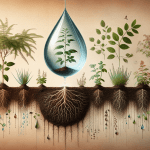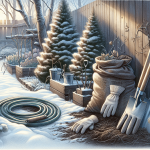This post may contain affiliate links. As an Amazon Associate, we may earn commissions from qualifying purchases.
Are you interested in expanding your garden or sharing your favorite plants with friends and family? If so, you may be wondering how to propagate plants through cuttings or division. This article will provide you with all the necessary information and step-by-step guidance to successfully propagate your plants using these two popular methods. Whether you’re a beginner or a seasoned gardener, you’ll find valuable tips and techniques to help you multiply your plant collection and bring the joy of gardening to others. So, let’s get started on this rewarding journey of plant propagation!
What is plant propagation?
Definition
Plant propagation refers to the process of creating new plants from existing ones. It is a method commonly used by gardeners and horticulturists to increase their plant stock and create multiple copies of a desirable plant. Plant propagation can be done through various methods such as cuttings, division, layering, grafting, and using seeds.
Importance of plant propagation
Plant propagation plays a vital role in horticulture and gardening for several reasons. Firstly, it allows us to create new plants without the need to rely on seed production, which can be unpredictable or time-consuming. Propagation also helps to maintain the characteristics of specific plant varieties, ensuring that desirable traits are preserved and passed on to future generations. Additionally, plant propagation offers an affordable and efficient way to expand plant stock, making it an essential technique for both amateur gardeners and commercial growers.
Methods of plant propagation
Cuttings
One of the most common methods of plant propagation is through cuttings. Cuttings involve taking a portion of a plant, typically a stem or a leaf, and encouraging it to develop roots and grow into a new plant. Depending on the type of plant, cuttings can be taken from softwood, semi-hardwood, or hardwood stems. This method is popular because it allows for rapid reproduction of plants and helps to maintain the characteristics of the parent plant.
Division
Division is another widely used method of plant propagation, especially for perennial plants. It involves dividing an existing plant into smaller sections, each with its own roots and stems. This method is particularly suitable for plants with clumping or spreading growth habits, such as hostas or daylilies. Division not only helps to create new plants but also helps rejuvenate older plants by promoting healthy growth and flowering.
Layering
Layering is a propagation technique that involves encouraging a plant to develop roots while still attached to the parent plant, before detaching it to form a new individual. This method is commonly used for plants with flexible and low-growing stems, such as strawberries or certain shrubs. Layering allows the new plant to receive nutrients and water from the parent plant until it is ready to be separated. It is a relatively easy and effective way to propagate plants with minimal equipment or expertise.
Grafting
Grafting is a more advanced method of plant propagation that involves joining the tissues of two different plants together. The upper part, known as the scion, is taken from the desired plant with desirable traits, while the lower part, known as the rootstock, provides the roots and stability. Grafting is often used to combine the strengths of two different plants into one, such as creating a tree that produces multiple fruit varieties. It requires specific techniques and knowledge to ensure successful union and growth.
Seeds
Seed propagation is the most natural and traditional method of plant reproduction. It involves collecting seeds from mature plants and sowing them in a suitable growing medium. Seeds contain all the genetic information necessary to grow into a new plant. While it may take longer for plants to grow from seeds compared to other propagation methods, this technique offers the advantage of genetic diversity, as seeds produced through sexual reproduction can result in unique variations. Seed propagation is commonly used for annuals, perennials, and plants that do not propagate well through other methods.

Propagating plants through cuttings
Types of cuttings
There are several types of cuttings, each suitable for different plants and growth stages. Softwood cuttings are taken from new, actively growing shoots and are ideal for plants like herbs and shrubs. Semi-hardwood cuttings are taken from partially mature stems and are typically chosen for woody plants and shrubs. Hardwood cuttings are taken from dormant stems during the winter months and are commonly used for deciduous trees and shrubs. Leaf cuttings involve taking a leaf from a plant and encouraging it to develop into a new plant, commonly used for plants with fleshy leaves like African Violets.
Selecting the right plant
When choosing a plant for propagation through cuttings, it is essential to select a healthy and disease-free specimen. Look for plants with vibrant foliage, strong stems, and no signs of pest damage or disease. Additionally, it is important to ensure that the plant has the capability to root from cuttings, as not all plants can be successfully propagated using this method.
Preparing the cutting
To prepare the cutting, use a sharp, clean pair of pruning shears to cut a piece of stem or leaf from the parent plant. The cutting should ideally be 4-6 inches long, taken from a healthy portion of the plant. Remove any lower leaves from the cutting, leaving a few at the top for photosynthesis. Using a clean, sharp blade, make a clean cut just below a node, which is where roots are likely to form.
Rooting hormones
Rooting hormones can be used to improve the chances of successful rooting in cuttings. These hormones, available in powder, liquid, or gel form, contain growth regulators that stimulate root development. Dip the cut end of the cutting into the rooting hormone, ensuring it is evenly coated, and gently tap off any excess. This will help encourage the growth of roots from the cutting.
Planting the cutting
Once the cutting has been prepared, it is time to plant it in a suitable growing medium. Use a well-draining potting mix or a mixture of perlite and peat moss to provide the cutting with the necessary nutrients and moisture. Make a hole in the soil with a pencil or dibber, insert the cutting into the hole, and gently firm the soil around it to ensure good contact.
Caring for the cutting
After planting, it is important to provide proper care for the cutting to ensure its successful rooting and growth. Place the cutting in a warm and bright location, but avoid direct sunlight, as this can cause wilting or scorching. Keep the soil consistently moist but not waterlogged, as excess moisture can lead to rotting. Monitor the cutting regularly for signs of growth and adjust the care accordingly.
Transplanting the rooted cutting
Once the cutting has developed a good root system and shows signs of healthy growth, it can be transplanted into a larger pot or directly into the garden. Gently lift the rooted cutting from its container, being careful not to damage the delicate roots, and plant it in a prepared hole. Water thoroughly after transplanting to help settle the soil around the root system.
Propagating plants through division
Plants suitable for division
Division is a popular method of propagating plants, especially those that naturally form clumps or have multiple stems arising from a central base. Perennials like daylilies, hostas, and ornamental grasses are commonly divided to create new plants. Plants that have become overcrowded or have stopped flowering as profusely as they used to are good candidates for division.
Timing for division
The timing for division depends on the specific plant and its growth cycle. Generally, it is best to divide plants either in early spring or in late summer. Spring division allows the plant to establish new roots and take advantage of the upcoming growing season. Late summer division gives the plant time to settle in before the arrival of winter.
Preparing the plant
Before dividing the plant, it is important to prepare it properly. Start by watering the plant thoroughly a day or two before division to ensure it is well-hydrated. This will help reduce stress on the plant during the division process. If the plant has a large, dense root ball, gently loosen the soil around the roots using a garden fork or your hands.
Dividing the plant
To divide the plant, carefully lift it out of the ground or container, ensuring that as much of the root system is retained as possible. Divide the plant into smaller sections, taking care to separate each section into clumps with their own roots and shoots. Use a sharp knife or a garden spade to make clean cuts, avoiding any damage to the plant tissues.
Planting the divisions
Once the plant has been divided, it is time to plant the divisions in their new locations. Dig a hole slightly larger than the size of the division and place it into the hole, ensuring that the original soil level matches the level of the division. Backfill the hole with soil, gently firming it around the roots to eliminate air pockets. Water the newly planted divisions thoroughly to help settle the soil.
Caring for the divided plants
After division, it is important to provide proper care for the divided plants to ensure their successful establishment. Keep the soil consistently moist for the first few weeks to help the divisions develop roots and adjust to their new surroundings. Monitor the plants for any signs of stress or wilting and adjust the watering accordingly. Apply a layer of mulch around the base of the plants to help conserve moisture and suppress weed growth.

Advantages of plant propagation through cuttings or division
Maintaining characteristics
One of the significant advantages of plant propagation through cuttings or division is the ability to maintain the characteristics of the parent plant. When using these methods, the new plants that are produced will have the same genetic traits as the parent plant, including flower color, growth habit, and disease resistance. This is especially desirable when propagating plants with specific characteristics or unique traits.
Multiple plant propagation
Plant propagation through cuttings or division allows for the creation of multiple new plants from a single parent plant. This can be particularly useful when propagating rare or expensive plants that may be challenging to find or purchase. Creating multiple plants also allows for more flexibility in garden design, as multiple specimens can be placed throughout the landscape to create a cohesive and balanced look.
Faster growth and establishment
Propagating plants through cuttings or division can lead to faster growth and establishment compared to other methods, such as seed propagation. By taking a cutting or dividing a plant, the new individual already has established roots and a supply of nutrients from the parent plant, resulting in quicker growth and establishment. This is particularly beneficial for plants that have a slow growth rate or have difficulty establishing from seeds.
Cost-effective method
Propagation through cuttings or division is a cost-effective method of creating new plants. It eliminates the need to purchase expensive seeds or established plants, as the new plants can be easily produced using existing materials. Additionally, by propagating plants through these methods, gardeners can save money by not having to replace older plants with new ones, as they can simply divide or take cuttings from the existing ones.
Common mistakes to avoid
Using unhealthy or diseased plant material
One of the most crucial mistakes to avoid when propagating plants is using unhealthy or diseased plant material. Plants that are weak or stressed are less likely to successfully root or establish, leading to poor growth or even death. It is essential to carefully inspect the parent plant for any signs of pests, diseases, or nutrient deficiencies before taking cuttings or dividing it.
Improper cutting technique
Another common mistake is using improper cutting technique. When taking cuttings, it is important to make clean cuts just below a node to ensure the best chances of rooting. Avoid using dull or dirty tools, as this can damage the plant tissues and introduce diseases. Proper cutting technique includes sterilizing the tools with rubbing alcohol or a bleach solution between each cut to prevent the spread of pathogens.
Neglecting environmental conditions
Proper environmental conditions are crucial for successful propagation. Avoid placing cuttings or divided plants in direct sunlight, as this can cause excessive drying or scorching. Provide adequate humidity by covering the cuttings with a plastic bag or using a misting system. Monitor and adjust temperature and moisture levels to optimize the chances of successful rooting and establishment.
Over or under-watering
Maintaining the right moisture levels is essential for successful propagation. Over-watering can lead to root rot and the development of fungal diseases, while under-watering can cause the cutting or division to dry out and fail to root. Regularly check the moisture level of the growing medium, and water as needed to keep it consistently moist but not waterlogged.
Using incorrect rooting medium
Using the correct rooting medium is crucial for successful propagation. Different plants have different rooting requirements, and using the wrong medium can hinder root development. Choose a well-draining medium that provides stability and moisture retention. For cuttings, options include perlite, vermiculite, or a mixture of peat moss and sand. For divisions, use a high-quality potting mix that provides both nutrients and aeration.
Neglecting proper care during root development
Proper care during the root development stage is critical for successful propagation. Monitor the cuttings or divided plants regularly for signs of growth and root development. Adjust the care routine accordingly, ensuring they have appropriate light levels, humidity, and moisture. Avoid disturbing the root system during this stage, as it can disrupt the root development and hinder successful establishment.
Choosing the right plants for propagation
Perennial plants
Perennial plants, which live for multiple years, are excellent candidates for propagation. They often readily produce offsets or have clumping growth habits that allow for easy division. Perennials like hostas, ornamental grasses, and daylilies are commonly propagated through division and provide a reliable source of new plants.
Herbaceous plants
Herbaceous plants, which have non-woody stems, are generally easier to propagate through cuttings or division compared to woody plants. Examples include various herbs like basil, thyme, and rosemary, as well as decorative plants like geraniums. These plants tend to root and establish more quickly, making them suitable for beginners or those looking for quick results.
Easy-to-propagate species
Some plants are inherently easier to propagate than others. These “easy-to-propagate” species often have a high success rate and require minimal special care. Examples include succulents like jade plants or sedums, which can be easily propagated through leaf or stem cuttings. This category also includes fast-growing plants like coleus or impatiens, which readily root and establish from cuttings or stem sections.
Plants with desirable traits
Another factor to consider when choosing plants for propagation is their desirable traits. This could include plants with specific flower colors, unique foliage patterns, or exceptional fragrance. By propagating plants with desirable traits, gardeners can create multiple copies of these characteristics and enhance the overall beauty and diversity of their garden.
Factors affecting success rate
Environmental conditions
The success rate of plant propagation can be significantly influenced by environmental conditions. Temperature, light levels, humidity, and airflow all play crucial roles in successful root development and growth. Providing the optimal conditions for each specific plant type can greatly increase the chances of successful propagation.
Season
Seasonal timing can also impact the success rate of plant propagation. It is important to understand the specific growth cycle of the plant being propagated and choose the appropriate season for division or taking cuttings. Different plants have different times of the year when they are most receptive to propagation.
Plant maturity
The maturity of the plant being propagated can affect the success rate. Younger plants generally root and establish more quickly compared to older, more mature plants. It is important to choose a parent plant that is healthy and in its prime for optimal results.
Proper tools and equipment
Using the right tools and equipment is essential for successful plant propagation. Sharp and clean pruning shears or knives ensure clean and precise cuts, reducing the risk of damage or disease transmission. Other tools, such as misting systems or heat mats, may also be necessary to create the ideal conditions for rooting and growth.
Experience and technique
Experience and technique acquired through practice and learning from mistakes can significantly impact the success rate of plant propagation. As with any skill, the more you practice, the better you will become at identifying suitable plants, choosing the right methods, and providing appropriate care. Learning from experienced gardeners or horticulturists can also provide valuable insights and tips for successful propagation.
When to propagate plants through cuttings or division
Plant’s growth stage
The growth stage of the plant is crucial in determining the appropriate time for propagation. For cuttings, taking them from a plant during its active growth phase, when it is producing new shoots and leaves, generally yields the best results. However, for certain plants, like deciduous trees, taking hardwood cuttings during the dormant season may be more successful. Similarly, for division, timing can depend on whether the plant is actively growing or entering a dormant period.
Timing for optimal results
Timing plays a crucial role in maximizing the success of plant propagation. For most plants, it is best to propagate them in the spring when they are actively growing and have sufficient energy to produce new roots. However, some plants may benefit from propagation during different times of the year, such as late summer or early fall. Understanding the specific requirements of each plant, including its growth cycle and response to environmental conditions, will help determine the ideal timing for propagation.
Conclusion
In conclusion, plant propagation is a valuable technique for gardeners and horticulturists to expand their plant stock and create multiple copies of desirable plants. Methods such as cuttings, division, layering, grafting, and seeds allow for the efficient reproduction of plants with minimal resources. Propagating plants through cuttings or division offers advantages such as maintaining desirable characteristics, producing multiple plants, promoting faster growth and establishment, and being a cost-effective method. However, it is important to avoid common mistakes, choose the right plants, consider various factors affecting success, and understand when to propagate plants for optimal results. With proper knowledge and care, anyone can successfully propagate plants and enjoy a more diverse and thriving garden.








